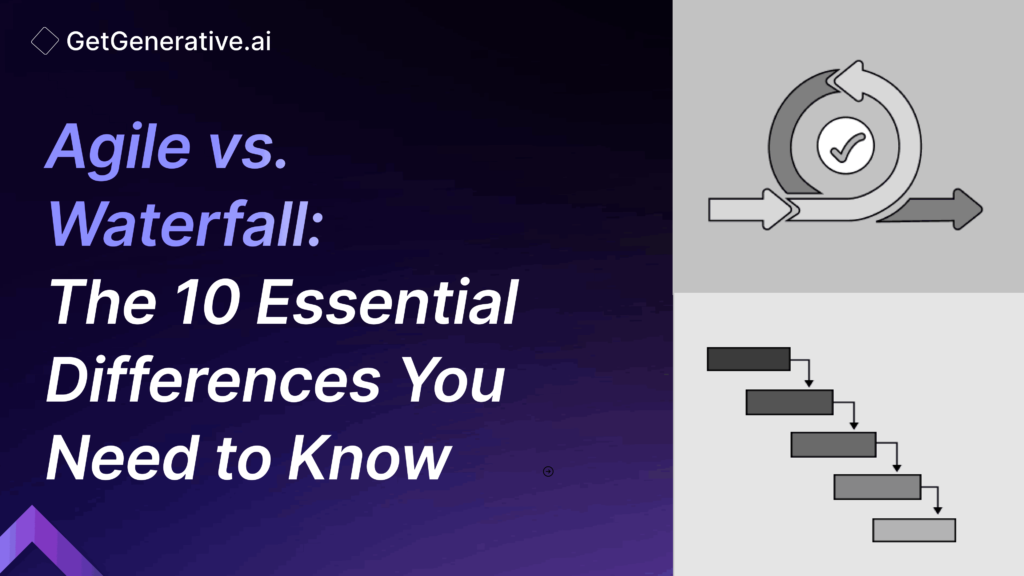Agile vs. Waterfall: The 10 Essential Differences You Need to Know
Understanding the differences between Agile and Waterfall is crucial in project management. These two methodologies, each with its own set of advantages, limitations, and applications, play a significant role in achieving project success.
Let’s break down the key distinctions between Agile and Waterfall.
What is Agile?
Agile, a highly flexible and iterative methodology, finds its practical application in software development. It emphasizes collaboration, adaptability, and the frequent delivery of functional product increments. The project evolves through short cycles called sprints, where teams work closely together and adjust to new information or requirements. The focus is on delivering continuous value to customers, allowing for fast feedback and modifications.
What is Waterfall?
The waterfall strategy follows a sequential, step-by-step approach, providing a sense of predictability and security. It includes up front rigid planning where the scope of the entire project is defined prior to any work taking place. This method is best suited to projects with known requirements and deadlines since only when a phase is complete do we move to the next and a full phase is completed.
Key Differences Between Agile and Waterfall
1. Flexibility and Adaptability
One of the most significant differences between Agile and Waterfall lies in how they handle change. Agile is designed to be highly flexible, welcoming adjustments even late in the project. This means that teams can pivot quickly in response to customer feedback or market changes.
Waterfall, however, is far more rigid. Once a phase is completed, making changes can be time-consuming and costly, as you may need to backtrack and revise completed phases.
2. Project Scope Management
Managing project scope takes the opposite approaches to Waterfall and Agile. In Agile, the scope is fluid and evanescent as the project progresses. Costs continue to escalate, requirements change, and the scope is continually refined to meet ongoing project needs.
The scope is fixed in Waterfall at the outset. This makes it hard for teams to modify mid-project because any changes to the initial plan can cause these problems, resulting in huge delays and cost overruns.
3. Timelines and Speed of Delivery
With short cycles of development, typically 2 – 4 weeks, Agile emphasizes speed. Each sprint ends with teams delivering a functional product increment in a piece, which results in faster releases.
However, the waterfall project takes a linear timeline, and each phase has to be completed before one can move on to the next. It may mean a longer project duration since none of the project is completed until all is complete.
4. Customer and Stakeholder Involvement
Frequent involvement of customers is what Agile methodology thrives on. This continuous feedback loop ensures that every step through the project is done with the end users in mind, making sure the final product is what they expect.
In a waterfall project, systems and customers interact only at the beginning and the end of the project; this can sometimes result in mismatched results if the original requirements are not completely captured.
5. Collaboration and Team Dynamics
Agile leads to a very agile team from within, which collaborates highly and can adapt. Agile teams are cross-functional teams, i.e., people involved in the project involved in many aspects of the project.
The more hierarchical waterfall has different roles and responsibilities for each team member having just one step at a time, which doesn’t generate as collaborative a dynamic.
Also Read – Types of Agile Methodologies: Principles and Applications
6. Managing Risks and Uncertainties
Risk management is possible during agile due to the fact that risks can be addressed as they are realized by each sprint. By doing so, potential problems are caught early.
However, waterfall identifies risks at the very first step of a project and deals with them through complete planning. Waterfall projects are more vulnerable to last-minute changes because risks may not be apparent until the late stages.
7. Cost and Budget Control
Agile projects tend to have more flexible budgets, as costs can fluctuate depending on the number of sprints and the evolving scope. This flexibility allows Agile teams to adapt their resources as needed.
Waterfall, on the other hand, usually operates within a fixed budget that is set during the initial planning phase. While this can provide predictability, it can also result in cost overruns if changes are needed.
8. Documentation Requirements
Waterfall places a heavy emphasis on documentation. Each phase is meticulously documented, providing a clear roadmap for all project stages. This makes Waterfall ideal for projects that require detailed records and structured workflows.
In contrast, Agile values working software over extensive documentation. Agile teams typically keep documentation light, focusing on collaboration and real-time communication to guide their efforts.
9. Testing Approach
In Agile, testing is integrated into every sprint. Continuous testing ensures that any issues are addressed immediately, and the product’s quality is consistently high.
Waterfall, on the other hand, reserves testing until the end of the project. While this allows for a comprehensive review, it also means that any issues found may require significant rework, causing delays.
10. Approach to Success Measurement
Another critical difference between Agile and Waterfall is how success is measured. In Agile, success is measured by the continuous delivery of functional increments that add value. Each sprint is an opportunity to assess the team’s progress, adjust the direction, and ensure the project is on track. Success is fluid and adapts to the evolving needs of the stakeholders.
In contrast, Waterfall measures success based on the completion of predefined milestones. Each phase must be fully completed before moving to the next, and success is only assessed once the final product is delivered. This can sometimes result in delayed feedback and a lack of immediate insight into the project’s progress.
Also Read – Best Agile Tools to Boost Project Management
Which Methodology Should You Choose?
The choice between Agile and Waterfall depends on the specific needs of your project. Agile is ideal for projects where flexibility, collaboration, and frequent feedback are essential. It’s best suited for software development, creative endeavors, or projects with evolving requirements.
Waterfall, by contrast, is better suited for projects with well-defined goals, fixed timelines, and minimal changes, such as construction projects or industries requiring strict adherence to regulations.
Conclusion
Agile and Waterfall each offer unique approaches to project management, and the right choice depends on your project’s characteristics. If adaptability and speed are critical, Agile provides the flexibility to adjust and deliver quickly. However, if predictability and structure are your top priorities, Waterfall offers a well-planned roadmap to ensure project success.
To learn more, visit GetGenerative.ai today!
FAQs
1. Can Agile and Waterfall be used together in a project?
Yes, hybrid models that combine Agile and Waterfall elements are sometimes used, depending on the project’s needs. These are often called hybrid methodologies or “Watergile.”
2. Which industries prefer Waterfall over Agile?
Industries like construction, manufacturing, and government, where projects have strict regulations and require detailed documentation, often prefer Waterfall.
3. Is Agile more cost-effective than Waterfall?
While Agile might seem more expensive initially due to its iterative nature, it often reduces costs in the long run by addressing issues early. Waterfall’s fixed cost can result in higher expenses if changes occur late in the project.
4. How does Agile manage scope changes better than Waterfall?
Agile allows for continuous adjustments to the project scope, while Waterfall has a fixed scope that is difficult to modify without significant replanning.
5. What is the biggest drawback of the Waterfall methodology?
The biggest drawback is its rigidity. Once a phase is completed, changes are challenging to implement, making it less suitable for projects with evolving requirements.




